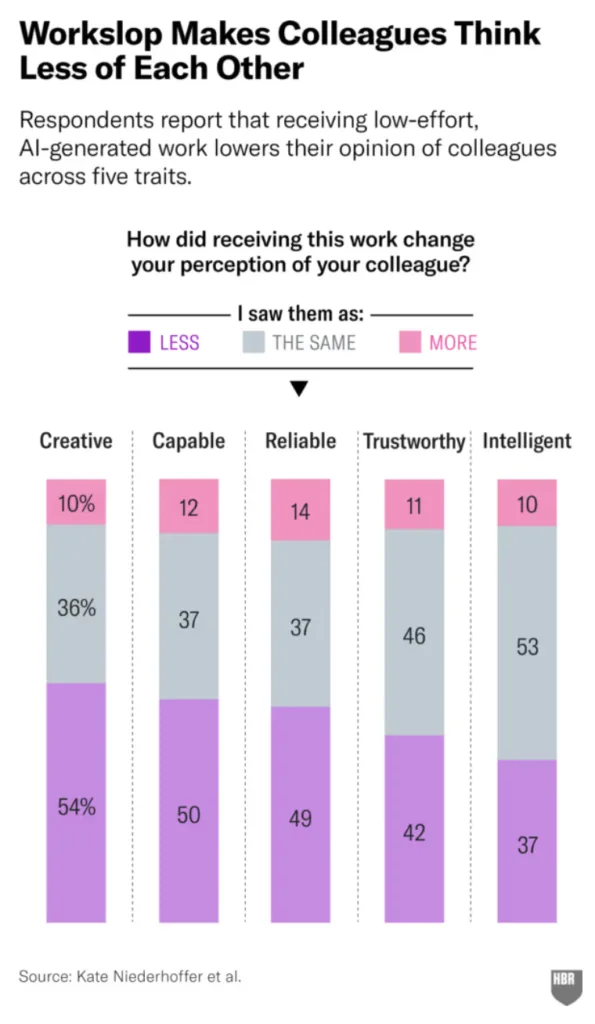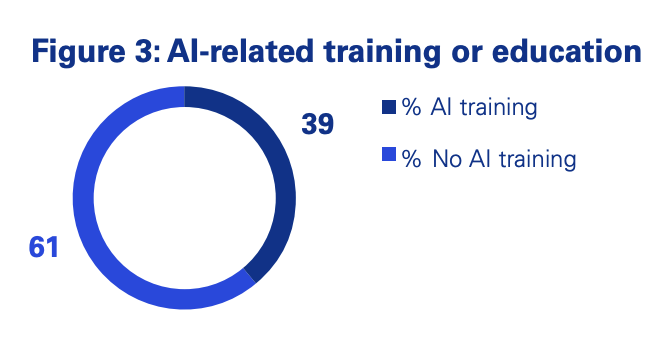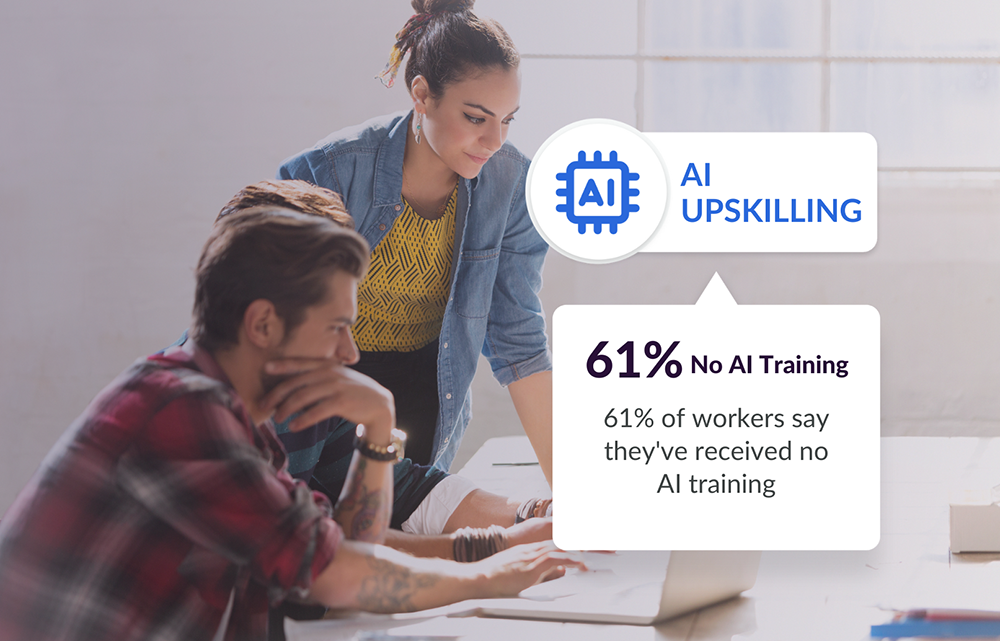ChatGPT’s official launch in 2022 marked the beginning of a new era of employee skill development. What was once seen as either a fun toy or a business security threat (depending on who you’re talking to) has rapidly become a required skill for employees. Consequently, AI upskilling is now one of the most critical mentoring trends in 2026 and beyond, and one that HR leaders simply can’t ignore.
In fact, upskilling employees in AI may be one of the most essential employee development trends we’ve ever seen. It’s just that important.
The urgency for employees to learn how to use AI tools effectively, responsibly, and safely grows by the day. Companies must teach their employees how to use AI for massive productivity gains, while also navigating critical security and ethics concerns that are unavoidable with AI-native tools and generative AI. Leaders must make upskilling in AI an imperative over the next 12 months or risk falling behind both in the battle for talent and in the marketplace battle against their competitors.
Beneficially, the secret to rapidly scaling AI skill development likely already exists within the company ranks. All that’s needed is to identify who has the skills and tap into those skills through scaled and structured mentoring relationships.
This trend is part of our 3-part National Mentoring Month series on mentoring trends for 2026. We recommend you read our other two trends posts:
Why Is AI Upskilling A Top Mentoring Trend for 2026?
There are 3 impossible-to-ignore reasons why AI upskilling is a top mentoring trend for 2026 (and beyond):
1. Effective AI usage increases productivity (and ineffective AI usage does the opposite)
Take note of the keyword in that subheading: effective. There are three types of employees in your business right now:
- Those who use AI tools regularly (multiple times per week or even daily)
- Those who use AI tools occasionally (once or twice per week or even a few times per month)
- Those who rarely or never use AI

The individuals you need to worry about most here are #2 and #3. Those in your organization who use AI tools occasionally may lack the requisite skills to use them effectively. They’re the ones most likely to produce what some researchers are calling “AI Workshops.” Workslop is poorly created AI content that causes more harm than good.
According to AI researchers publishing in the Harvard Business Review, ineffective AI usage can force colleagues to spend around 2 hours reworking AI content. And receiving poorly created AI-generated content from colleagues can hurt working relationships. When forced to redo bad work created by AI:
- 54% think their colleagues are less creative
- 50% think their colleagues are less capable
- 49% think their colleagues are less reliable
- 42% think their colleagues are less trustworthy
- 37% think their colleagues are less intelligent.
Herein lies the issue. Your employees are going to use AI. Unless they’re daily users who know how to critique their own work, they’re likely to use it poorly. That’s going to cause a negative impact on your productivity and company culture.
Meanwhile, a Cornell University study found that workers paired with AI agents saw a 73% greater productivity than those not paired with one, alongside improvements in the quality of their work. And the Federal Reserve Bank of St. Louis found that generative AI saves workers an average of 2.2 hours of work per week. Separately, over 50% employees who report they use AI every day say AI saves them 3 or more hours of work per week.
This time saving frees employees up to do more than they’ve done in the past. And, combined with the overall quality increase in work output through the effective use of AI tools, companies stand to reap the benefits on the bottom line.
Again, as long as employees know what they’re doing.
Just ask Deloitte Australia, which had to issue a nearly $500,000 refund to a customer after it provided a report that had multiple errors generated by AI, including references to research that didn’t exist (a common AI hallucination).
Done well, AI usage is a boon to companies. Done poorly? It’s going to cost you. However, you can’t ignore the fact that your competitors will ultimately use it. It comes down to whose employees are using AI tools effectively.
2. Employees will use AI whether you like it or not (and whether or not they know what they’re doing)
AI Upskilling with Mentoring
Download Our Free Whitepaper + Strategy Guide
Many workers will seize any opportunity they can to save time at work, especially if they’re already feeling overworked.
Education technology company Moodle found that 66% of employees feel overworked right now. And although companies spend an average of $1,500 per year per employee on skill development, that money is likely going to waste, considering:
- 25% of employees feel the training is ineffective
- 46% speed up training videos or multitask while playing them
- 14% mute the audio or click through questions too quickly to absorb any learning from them
Why are people feeling so burned out and completely ignoring your training efforts?
- 24% say they have more work than time to complete it
- 24% say they don’t have enough resources to do their jobs correctly
- 20% are in a well-being crisis due to the economy
- 19% are taking on too much work due to labor shortages
- 13% are worried about how AI will impact their role
Constant rounds of layoffs and empty positions that need to be filled are leading workers to leverage AI tools just to get by. However, as we mentioned earlier, many people aren’t using AI tools correctly, resulting in lower productivity for their colleagues, harming your culture in the process, and potentially costing the company hundreds of thousands of dollars.
Some of your employees are getting AI usage right. But the larger your organization, the less likely you are to know who these individuals are, especially if you have restrictive AI policies in place.
They’re using AI; they’re just not telling you.
In a joint study, KPMG and the University of Melbourne found that 57% of employees hide their AI usage from their employers. And yet, that same study found that:

- 60% of people have received no AI training
- 79% report their understanding of AI to be either low or moderate
- 55% feel they can effectively evaluate the accuracy of AI output.
- 62% believe they can skillfully use AI at work
This is a danger zone for companies going into 2026. Policies and personal knowledge be damned, your people are going to use AI, and half of them can’t really tell whether what they’re delivering is even accurate. Many users are overwhelmingly overconfident in their capabilities with AI.
This is how you get a company as large as Deloitte putting out reports with AI-generated hallucinations.
Companies must get ahead of AI usage. That means not banning it, but adopting it by leveraging the know-how of internal experts who can teach others the right way to use these tools.
3. Employees are hungry to learn how to use AI tools, but in a more hands-on way
There’s a bright light at the end of the upskilling tunnel here. KPMG and the University of Melbourne note that 83% of people are interested in learning more about AI (90% in emerging economies). The study summarizes its findings in perhaps the most eye-opening way:
“…these findings indicate high rates of AI adoption by the public, coupled with comparably low levels of AI training and literacy.” – KPMG + University of Melbourne, “Trust, attitudes, and use of artificial intelligence”, 2025
People want to learn how to use AI. They’re going to use it anyway, but they have a strong desire to learn how to use it effectively, especially at work. How you teach them will impact both the rate of adoption and the safe and functional use of AI across your organization.
Here’s a real kick-in-the-pants stat for US L&D leaders from the earlier-referenced Moodle survey:
- 52% of American employees are using AI to complete mandatory work training, including answering questions and even taking the entire training for them.
Let that one sink in. People will likely use AI to skip right through self-directed AI upskilling attempts. Unless you make AI upskilling human and hands-on, you’re not likely to get the kind of successful adoption that you’re hoping for.
Instead, you’ll get reports full of AI hallucinations, completely manufactured data, and very irate team members who have to go in and clean up the mess.
Mentoring Unlocks AI Upskilling in the Safest and Most Human Way Possible
Here’s the beautiful irony to this story: the solution to AI upskilling isn’t more AI. It’s more human connection.
Mentoring programs offer the hands-on, personalized learning experience that employees both want and need. Instead of clicking through yet another training module (or using AI to automate the process), employees can learn from colleagues who are already utilizing AI tools effectively in real-world work scenarios.
These are the people who know how to spot hallucinations, craft effective prompts, and integrate AI into workflows without compromising quality or security.
And they’re already in your organization. You just need to find them and scale their expertise.
Why mentoring works for AI upskilling when traditional training fails
Remember those statistics about employees speeding through training videos and muting audio? That’s not going to happen in a one-on-one mentoring relationship.
Here’s why mentoring is uniquely positioned to solve the AI upskilling crisis:
- Real-world application over theory. Mentors can show mentees exactly how they use AI tools in their daily work. Not hypothetical scenarios from a generic training course, but actual use cases relevant to your industry, your company, and their specific role. A marketing mentor can demonstrate prompt engineering for campaign copy. An engineering mentor can show how to use AI for code review without introducing security vulnerabilities.
- Immediate feedback and course correction. When a mentee creates their first AI-assisted deliverable, their mentor can review it in real-time, catching potential “workslop” before it reaches colleagues. This prevents the damage to relationships and productivity that poorly executed AI outputs create. It’s the difference between learning to drive with an experienced driver beside you versus watching a video about driving and then getting behind the wheel alone.
- Built-in accountability and engagement. People don’t ghost their mentors the way they ghost training modules. The relationship itself creates accountability. Mentees actually want to show up, learn, and improve because there’s a real person invested in their growth. And mentors benefit too, often reporting that teaching others deepens their own understanding and keeps them current on emerging AI best practices.
I’ve seen this work in practice. I’ve been an avid user of generative AI since it first hit the scene in 2022. I’ve used it almost daily for the past several years, adapting to changes, new tools, and new features. More than that, I pay close attention to the industry, so I’m familiar with the strengths, weaknesses, and dangers that exist with AI.
After seeing the many vibe-coded tools I was creating, my colleague Pierre Habib reached out for some flash mentoring on how to do the same. I was able to take what I know and show him how to replicate that success on his own.
Not all of your employees are going to be as outspoken about their AI use as I am with my team. That doesn’t mean those individuals don’t exist. They do. You’ll just need to root them out, integrate them into your mentoring programs as mentors regardless of their tenure, and leverage their expertise.
Addressing the security and ethics elephant in the room
One of the biggest concerns around AI adoption is security. Data exfiltration is a major concern, as is leaked data more generally. What data is being fed into these tools? How do you prevent sensitive information from leaking? What are the ethical implications of using AI for certain tasks?
Earlier in 2025, both ChatGPT and Grok were caught having indexed hundreds of thousands of personal chats. Those chat logs contained tons of PII, company data, and very private information about individuals. I’ve read some of these myself. The amount of information is troubling, at best. For some, it was likely devastating.
OpenAI has since removed those indexes and set chats only to index by user choice. There are still thousands of Grok chats indexed on Google.
Mentoring relationships provide the perfect environment to address these concerns head-on. Instead of a blanket policy that employees will inevitably work around, mentors can teach the why behind safe AI usage. They can share real examples of what happens when security protocols aren’t followed. They can help mentees develop good judgment about when to use AI and when not to.
This nuanced, context-specific guidance simply can’t be replicated in a standardized training course. And it’s exactly what employees need to use AI responsibly.
Scaling AI expertise without scaling headcount
Based on existing survey data alone, you likely already have the pool of mentors you need to scale an AI upskilling approach across your organization. You don’t need to hire an army of AI trainers or invest in expensive consultants. You can leverage the AI-proficient employees you already have, matching them with those who need upskilling.
A well-designed mentoring platform can identify your AI power users through skills assessments, usage patterns, or manager nominations. Then it can systematically pair them with employees who would benefit most from their expertise. One AI-savvy employee can mentor multiple people over time, creating a ripple effect of improved AI literacy across your organization.
And unlike that $1,500 per employee training spend that’s currently going to waste, mentoring programs generate measurable ROI. You can track not just completion rates, but actual improvements in work quality, productivity gains, and reduction in AI-related errors.
The competitive advantage from AI upskilling
Let’s be brutally honest: your competitors are figuring this out right now. The companies that successfully upskill their workforce in AI usage will have employees who are more productive, more innovative, and more satisfied with their work.
They’ll attract better talent because they’re known as organizations that invest in cutting-edge skills development.
Meanwhile, companies that ignore AI upskilling or rely solely on ineffective traditional training methods will struggle with the workslop problem and damaged team relationships as a result. That’s not to mention the potential reputational and business impact of poorly-generated AI content.
You can either proactively build AI competency through structured mentoring or you can reactively deal with the fallout of unguided AI adoption.
- One path leads to competitive advantage.
- The other leads to playing catch-up while cleaning up expensive mistakes.
The mentoring infrastructure to make this happen likely already exists in your organization or can be implemented quickly. The AI-proficient employees are already there. The eager learners are waiting. All that’s missing is the structured program to connect them.
Make AI upskilling through mentoring a priority in 2026, or risk being left behind by competitors who did.
What Do Employees Need to Learn About AI?
Upskilling in AI isn’t about turning every employee into a data scientist. It’s about building AI literacy and fluency across the organization so every person can use artificial intelligence effectively, safely, and creatively in their daily work. Through mentoring programs, companies should focus on five key skill areas:
1. AI Literacy and Responsible Mindset
Employees need a clear understanding of what AI is—and what it’s not. AI literacy covers the basics: knowing how analytical and generative AI differ, understanding that AI operates on pattern recognition (not human reasoning), and recognizing that tools like ChatGPT can still produce biased or fabricated results.
Mentoring should emphasize responsible AI use: awareness of bias, data privacy, fairness, and security protocols. With recent incidents where confidential conversations were exposed online, this isn’t theoretical—it’s essential. Building literacy helps employees see AI as a tool to enhance their judgment, not replace it.
2. Effective Prompt Engineering
Generative AI tools are only as good as the prompts they receive. Employees must learn how to “talk” to AI. That means understanding how to write precise, contextual, and detailed instructions that guide outputs effectively. This includes specifying role, format, tone, and desired outcomes. Mentorship can accelerate this learning by helping employees practice “prompt refinement”—iteratively improving results based on feedback from the AI. Good prompts turn average answers into great ones.
3. AI Tool Proficiency
Employees should be confident using the AI-powered tools embedded in their everyday software (like Microsoft 365 Copilot or CRM automation features) as well as role-specific applications. Mentorship can connect less-experienced users with “power users” who demonstrate how to integrate these tools into daily workflows—whether that’s forecasting in finance, content generation in marketing, or AI-assisted chat in customer support.
4. Data Interpretation and Analysis
AI doesn’t remove the need for human insight—it amplifies it. Employees should learn to interpret AI-generated analyses, visualize data, and question results. For example, HR teams might use AI to summarize survey feedback, but mentors should teach them to cross-check those insights and recognize when AI outputs may mislead. The goal: create critical consumers of AI insights who can connect data to decisions.
5. Critical Thinking and Continuous Learning
The more we automate, the more human discernment matters. Employees must verify AI’s results, spot errors, and think critically about what they’re seeing. From lawyers citing fake AI-generated cases to marketers publishing unchecked content, the cost of blind trust in AI is real.
Mentoring should also encourage continuous learning and adaptability. Tools will change rapidly—today’s “must-use” model may be outdated next year. A strong mentoring culture helps employees stay curious, experiment, and learn how to learn, ensuring their skills evolve in tandem with AI itself.
How Can Companies Quickly Build and Scale AI Upskilling?
Thankfully, building and scaling a mentoring program focused on AI upskilling is easier than you might think. There are 3 steps involved in the process:
1. Identify who knows how to use AI, and to what extent
Find those individuals within your organization who have that skill set in AI that you can leverage. MentorcliQ offers the best way to do this, through automated skill and personality surveys. You can quickly pull these people into the mentoring platform by having them come out of the shadows through self-identification.
Alongside this, you should also have your employees who want to learn or improve their AI skills take or update their mentoring profiles to that effect. That way, when you begin the pairing process, you know who has skills and who needs to learn.
2. Pair employees into mentoring relationships around AI skills
Automated matching can do this for you. Otherwise, you’ll find yourself doing the tedious work of matching by hand in spreadsheets. If you actually want or need to scale AI upskilling, automation is critical.
But think outside of the box here. You’re naturally going to have people with various levels of AI skills. You don’t need to pair every master with every newbie. You can pair people who are somewhat comfortable with those who have no experience as a Phase 1 upskilling task. Then, retotate relationships so that those who were new then get repaired with those who are more expert-level.
This graduated approach ensures that everyone is learning and leverages multiple skill levels.
There are multiple mentoring formats that can work here, as well.
- Reverse mentoring
- 1:1 traditional mentoring
- Flash mentoring
- Group mentoring
- Mentoring circles
The format you use will depend on how many people in your organization have the skills to teach (your mentor pool) and the strategies that align with your goals.
3. Measure results, adjust, and expand
No mentoring strategy is effective unless it’s properly measured. Tracking the impact of your AI upskilling program ensures that your mentoring efforts translate into real business outcomes and employee growth.
Start by defining what success looks like. Identify both learning outcomes (such as increased proficiency in key AI tools or improved understanding of AI concepts) and business outcomes (like faster workflows, better data-driven decision-making, or reduced errors through automation). Within MentorcliQ, these outcomes can be tied to specific mentoring goals—for example, “learn to use Microsoft Copilot for daily reporting” or “develop a process for using AI to generate client proposals.”
Quantitative data points might include:
- The number of employees who complete AI mentoring programs
- The increase in skill proficiency scores
- Engagement metrics showing how often AI tools are used effectively in daily tasks.
Qualitative data may consist of:
- Participant feedback
- Confidence ratings
- Mentor or mentee reflections
Qualitative data is beneficial for capturing the personal and cultural impact of the upskilling program, e.g., how people feel about using AI and how mentoring has influenced that comfort level. And quantitative data will put hard numbers to the effectiveness of your strategy. Both are important to do mid-cycle and post-cycle so you can adjust strategies before launching a new cycle.
Close the loop by using these insights to improve your program. If certain mentoring formats or tools drive better results, expand them. If you notice gaps—such as low participation from specific departments or skill levels—adjust your matching criteria or training focus. Regular measurement and iteration will keep your AI mentoring program dynamic, scalable, and aligned with business goals.
AI Upskilling + Mentoring = Future Success
AI skills are more than just a fad. They’re rapidly becoming essential workplace skills.
In the 1990s and early 2000s, it was not uncommon for companies to list “proficiency with Microsoft Office” as a core technical skill for just about white collar role. Now, productivity tool usage has been genericized; everyone knows how to do it, so making that a listed skill is almost unnecessary. AI literacy, however, will soon be that one technical skill everyone will need to prove when interviewing for a job.
Companies shouldn’t wait for that to happen. Internal upskilling strategies are already occurring. Accenture plans to “exit” employees who can’t be upskilled in AI. Walmart is gearing up to offer an AI skills program in collaboration with OpenAI.
The shift toward making AI a key skill has started. Launching an internal AI upskilling program now will help ensure your company stays ahead of this unavoidable trend.




